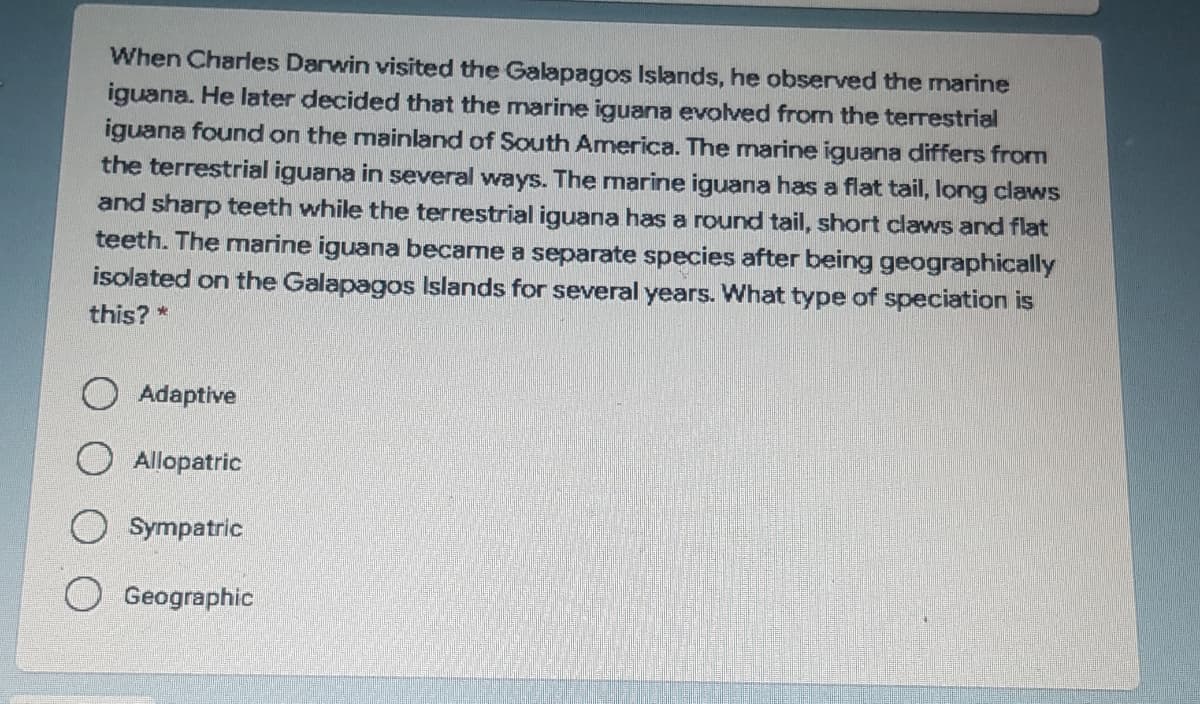When Charles Darwin visited the Galapagos Islands, he observed the marine iguana. He later decided that the marine iguana evolved from the terrestrial iguana found on the mainland of South America. The marine iguana differs from the terrestrial iguana in several ways. The marine iguana has a flat tail, long claws and sharp teeth while the terrestrial iguana has a round tail, short claws and flat teeth. The marine iguana became a separate species after being geographically isolated on the Galapagos Islands for several years. What type of speciation is this? * Adaptive Allopatric Sympatric Geographic
When Charles Darwin visited the Galapagos Islands, he observed the marine iguana. He later decided that the marine iguana evolved from the terrestrial iguana found on the mainland of South America. The marine iguana differs from the terrestrial iguana in several ways. The marine iguana has a flat tail, long claws and sharp teeth while the terrestrial iguana has a round tail, short claws and flat teeth. The marine iguana became a separate species after being geographically isolated on the Galapagos Islands for several years. What type of speciation is this? * Adaptive Allopatric Sympatric Geographic
Biology (MindTap Course List)
11th Edition
ISBN:9781337392938
Author:Eldra Solomon, Charles Martin, Diana W. Martin, Linda R. Berg
Publisher:Eldra Solomon, Charles Martin, Diana W. Martin, Linda R. Berg
Chapter18: Introduction To Darwinian Evolution
Section: Chapter Questions
Problem 15TYU: EVOLUTION LINK Although most salamanders have four legs, a few species that live in shallow water...
Related questions
Question

Transcribed Image Text:When Charles Darwin visited the Galapagos Islands, he observed the marine
iguana. He later decided that the marine iguana evolved from the terrestrial
iguana found on the mainland of South America. The marine iguana differs from
the terrestrial iguana in several ways. The marine iguana has a flat tail, long claws
and sharp teeth while the terrestrial iguana has a round tail, short claws and flat
teeth. The marine iguana became a separate species after being geographically
isolated on the Galapagos Islands for several years. What type of speciation is
this? *
Adaptive
O Allopatric
Sympatric
O Geographic
Expert Solution
This question has been solved!
Explore an expertly crafted, step-by-step solution for a thorough understanding of key concepts.
Step by step
Solved in 2 steps

Knowledge Booster
Learn more about
Need a deep-dive on the concept behind this application? Look no further. Learn more about this topic, biology and related others by exploring similar questions and additional content below.Recommended textbooks for you

Biology (MindTap Course List)
Biology
ISBN:
9781337392938
Author:
Eldra Solomon, Charles Martin, Diana W. Martin, Linda R. Berg
Publisher:
Cengage Learning

Biology Today and Tomorrow without Physiology (Mi…
Biology
ISBN:
9781305117396
Author:
Cecie Starr, Christine Evers, Lisa Starr
Publisher:
Cengage Learning

Biology: The Unity and Diversity of Life (MindTap…
Biology
ISBN:
9781337408332
Author:
Cecie Starr, Ralph Taggart, Christine Evers, Lisa Starr
Publisher:
Cengage Learning

Biology (MindTap Course List)
Biology
ISBN:
9781337392938
Author:
Eldra Solomon, Charles Martin, Diana W. Martin, Linda R. Berg
Publisher:
Cengage Learning

Biology Today and Tomorrow without Physiology (Mi…
Biology
ISBN:
9781305117396
Author:
Cecie Starr, Christine Evers, Lisa Starr
Publisher:
Cengage Learning

Biology: The Unity and Diversity of Life (MindTap…
Biology
ISBN:
9781337408332
Author:
Cecie Starr, Ralph Taggart, Christine Evers, Lisa Starr
Publisher:
Cengage Learning